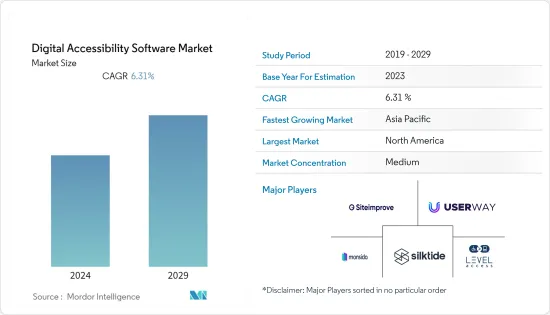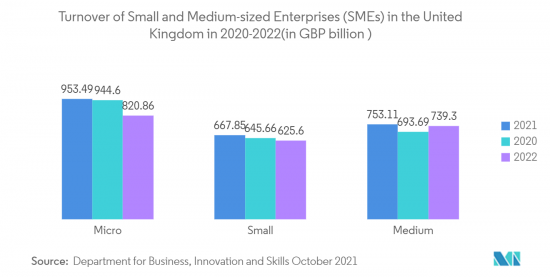PUBLISHER: Mordor Intelligence | PRODUCT CODE: 1408572

PUBLISHER: Mordor Intelligence | PRODUCT CODE: 1408572
Digital Accessibility Software - Market Share Analysis, Industry Trends & Statistics, Growth Forecasts 2024 - 2029

The Digital Accessibility Software Market size is estimated at USD 706.15 Million in the current year and is expected to reach USD 958.7 Million in the next five years, registering a CAGR of 6.31%.
Key Highlights
- Machine learning allows developers to save time and improve productivity by letting the algorithms do their job while concentrating on other pressing tasks that can't be automated. With the proper usage and implementation of machine learning, it is possible to automatically create alternative texts for pictures and make them more accessible for people with visual impairments.
- According to GSMA Intelligence. There are presently 6 billion mobile users globally, expected to reach 7.6 billion by the end of 2027. Therefore, it is high time that developers prioritize the smartphone experience and the desktop experience. With the development of 5G technology, the usage of mobile phones will continue to rise. Users use smartphones for booking tickets, online shopping, creating content, and other business-related needs. Therefore, web developers must focus on mobile web accessibility and its essential factors like small screen optimization, slow internet connection, touch-based navigation, etc. These things will drive the studied market.
- AI-powered chatbots can be another aspect of machine learning and can significantly enhance the user experience. They can answer people's questions and problems accurately and fast while engaging with web pages. They have been highly successful for e-commerce websites as well. Additionally, they can support businesses save time and money by automating customer service tasks, directing users to relevant information or resources, answering frequently asked questions, and even completing transactions. Features like text-to-speech, response time management, keyboard navigation, etc., can be connected with these AI-powered chatbots to demonstrate their role as a web accessibility solution.
- With the threat of legal activity looming, many businesses turn to accessibility vendors that sell inadequate solutions. These vendors span cheap, neither delivering ongoing accessibility, automation-only solutions to expensive manual audits, and compliance. Ambiguity Between Legal and Technical Frameworks will restrain the Market growth.
Digital Accessibility Software Market Trends
Government policies and laws will drive the market further
- Organizations in developing countries and Governments run several programs and regulations to assist small and medium-sized enterprises (SMEs) in the accessibility and usability of content for their website and mobile content. For instance, India's Rights of Persons with disabilities act, 2016, and Australia's Disability Discrimination Act (DDA) 1992 are some other acts and policies set by the government to provide equal opportunities to all users worldwide.
- In July 2023, the Justice Department sent to the Federal Register for publication a notice of offered rulemaking beneath Title II of the Americans with Disabilities Act (ADA) that aims to enhance web and mobile applications (apps) access for people with disabilities and refine how public entities - primarily state and local governments - can meet their current ADA obligations as many of their activities shift online. Across the United States, people rely on web and mobile apps to access vital public programs and services like employment and educational resources, health and emergency services, voting information, parking, and transit schedules. The proposed rule is especially significant in the wake of the pandemic, as public entities have enormously increased the scope of essential programs and services offered through the web and mobile apps. These technologies must be accessible to people with disabilities.
- The European Union's Charter of Fundamental Rights from 2000 and the EU's ratification of the United Nations Convention on the Rights of Persons with Disabilities (UN CRPD) in 2011 helped lead to the passage of the European Accessibility Act (EAA). The goal of accessibility is to create functional experiences for all. Everyone deserves to be able to participate in as many aspects of society as possible, and that extends to digital experiences. By pursuing accessibility, business can be part of creating something genuinely worthwhile. Over 100 million people have a disability in the EU. A business prioritizing digital accessibility will likely draw in some of that market. With an aged population, the number of individuals with disabilities in the EU will continue to increase. Old age brings specific disabilities, such as low vision, mobility, or cognitive disability. The EU has, therefore, legislated to support the rights of persons with disabilities.
- The level of web accessibility of government websites is gradually increasing, and a monitoring study of the essential accessibility of 100 government web resources has concluded. The monitoring study was conducted at the recommendation of the United Nations Development Programme (UNDP) in Ukraine from the end of 2022 to the beginning of 2023. Specifically, in 2021, 61 websites out of 100 were found to have achieved this level of accessibility, and 73 websites out of 100 analyzed at the beginning of 2023 had average or above-average essential accessibility, the study found. The study also recognized the five accessibility problems often appearing on government websites.
- The lack of a mechanism to quickly guide the main content, low text contrast, text for hyperlinks, the absence of a visible focus indicator during keyboard navigation, and errors in the page code. The report recommended how to fix the most common web accessibility errors. In addition, a unique method was developed for the government institutions where the research was conducted. Using it, creators and administrators of government websites can independently recognize and fix accessibility issues without any third-party technical assistance.

United States to hold the significant share
- Global Accessibility Awareness Day, on its 12th anniversary, is celebrated every year on the 3rd Thursday of May. The American Foundation for the Blind (AFB) encourages the US government to close the digital inclusion gap for Americans with disabilities and instantly fulfill the commitment of the Americans with Disabilities Act in the digital age. In April 2023, the American Foundation for the Blind (AFB) released a new report analyzing barriers to digital inclusion. The study found concerning data on the general walls that consumers who are blind run into when trying to complete basic tasks online.
- The study found that 28% of mobile apps and 21% of web users who were deafblind, blind, or had low vision underwent daily obstacles online. Over 80% of mobile and web users had problems finishing everyday tasks like online shopping, ordering food, online dating, monitoring a child's education, college coursework, or booking train, bus, and air travel. Similar frustrations also appeared with searching and applying for work.
- On May 2023, The Maryland Initiative for Digital Accessibility (MIDA) combines the expertise and passion of researchers, developers, and educators from multiple disciplines at the University of Maryland (UMD) to make digital technologies accessible. The world of digital technologies and content is often developed without considering the needs of individuals with disabilities. MIDA strives to change technology design research and practice to involve disability communities as equal members from the beginning of the design process, and accessibility is proactively built in. To achieve this, MIDA will include institutions that support and represent disability communities, designers, policymakers, and technology researchers.
- On May 2023- Wunderman Thompson announced its strategic partnership with the digital accessibility solution provider Level Access. Wunderman Thompson will leverage Level Access' software and decades of digital accessibility expertise to design and develop inclusive online experiences, such as websites and mobile apps, for its clients. However, most online experiences, including newly created ones, contain usability barriers for people with disabilities. Both Level Access and Wunderman Thompson are committed to closing this equity gap.
Digital Accessibility Software Industry Overview
Competitive rivalry in Digital Accessibility Software is competitive due to some key players like Silktide, Siteimprove, Monsido, UserWay, and LevelAccess.These companies can gain a competitive advantage over other players due to their ability to constantly innovate products and develop a product by forecasting the needs of their consumers. Hefty investments in research and development, mergers and acquisitions, and strategic partnerships have helped the companies gain substantial market share.
In January 2023, eSSENTIAL Accessibility, the pioneer of Accessibility-as-a-Service, and Level Access, the provider of enterprise digital accessibility solutions, have completed the next stage of their merger, announcing they have officially grown as one brand and will function as Level Access. The convergence of these two groups is now reflected in a new corporate logo and website that merges the identities of two of the most well-respected and well-known brands in digital Accessibility, featuring a unified product offering.
In January 2022, Vispero, the global leader in assistive technology products for the blind and low-vision community, was selected by McDonald's to assist in providing shoppers with an accessible kiosk experience. Vispero's product, JAWS Kiosk, has been deployed to decide on McDonald's US company-owned restaurants and newly deployed kiosks in US franchise locations. Creating an accessible and usable kiosk experience for McDonald's customers required an understanding of McDonald's robust self-order kiosk interface and a plan for creating a comprehensive McDonald's menu that is easily navigable and intuitive for blind customers.
Additional Benefits:
- The market estimate (ME) sheet in Excel format
- 3 months of analyst support
TABLE OF CONTENTS
1 INTRODUCTION
- 1.1 Study Assumptions and Market Definition
- 1.2 Scope of the Study
2 RESEARCH METHODOLOGY
3 EXECUTIVE SUMMARY
4 MARKET INSIGHTS
- 4.1 Market Overview
- 4.2 Industry Attractiveness - Porter's Five Forces Analysis
- 4.2.1 Bargaining Power of Buyers
- 4.2.2 Bargaining Power of Suppliers
- 4.2.3 Threat of New Entrants
- 4.2.4 Threat of Substitutes
- 4.2.5 Intensity of Competitive Rivalry
- 4.3 Industry Value Chain Analysis
- 4.4 Assessment of Macro-economic factor and its Impact on the Market
5 MARKET DYNAMICS
- 5.1 Market Drivers
- 5.1.1 Due to embedded accessibility features Smartphones present a useful tool for persons with disabilities , will drive market
- 5.1.2 Government schemes for disabled people
- 5.2 Market Restraints
- 5.2.1 lack of awareness of mobile accessibility features and mobile internet are key barriers
6 MARKET SEGMENTATION
- 6.1 By Type
- 6.1.1 Color Contrast Checker Software
- 6.1.2 Website Accessibility Software
- 6.2 By Organisation Size
- 6.2.1 Small and Medium Enterprises
- 6.2.2 Large Enterprises
- 6.3 By Geography
- 6.3.1 North America
- 6.3.2 Europe
- 6.3.3 Asia Pacific
- 6.3.4 Latin America
- 6.3.5 Middle East & Africa
7 COMPETITIVE LANDSCAPE
- 7.1 Company Profiles
- 7.1.1 Chrome Lens
- 7.1.2 Siteimprove
- 7.1.3 Monsido
- 7.1.4 UserWay
- 7.1.5 Dubbot
- 7.1.6 UsableNet AQA
- 7.1.7 Crownpeak Dqm
- 7.1.8 Silktide
- 7.1.9 Wave API
- 7.1.10 Level Access
- 7.2 *List Not Exhaustive
8 INVESTMENT ANALYSIS
9 MARKET OPPORTUNITIES AND FUTURE TRENDS




